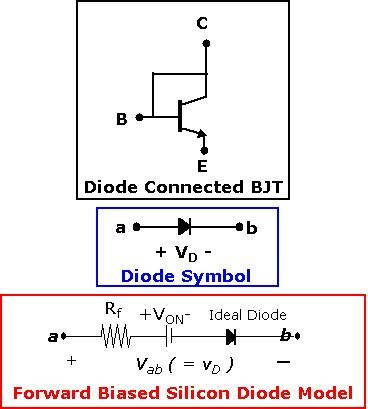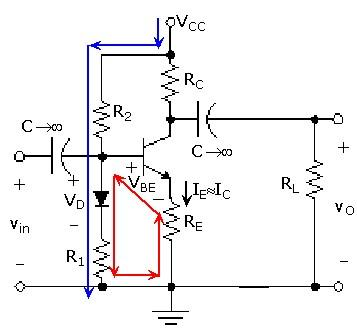Bias Compensation techniques: Diode Compensation:

In the previous section, we looked at how four parameters (VBE, VCC, and ICBO) can affect the total collector current and, hence, the Q-point of the amplifier. Diode compensation is a technique which is used to reduce the Q-point variations by selecting a diode which has temperature characteristics similar to that of the transistor. To make sure that diode and transistor have same temperature characteristics, we can use a BJT with the same stipulation as the amplifier transistor which is diode-connected. This includes shorting the collector to the base as shown in the figure to the right for PNP BJT (this can also be done with PNP BJTs). As a reminder, diode symbol and model for the forward biased silicon diode are also shown to the right - keep in mind that the current flows in the direction of the arrow, unless an ideal diode is specified, diode forward resistance and the turn-on voltage should be included in all calculations.

The diode is connected in the base circuit of the amplifier as shown in the Figure a, reproduced to the right. The addition of diode in this way allows temperature compensation since the VON of the diode varies in the same fashion as the VBE of the transistor. If transistors used in the amplifier and to construct diode are matched, the diode characteristics and base- emitter junction characteristics will be the same. Under these conditions, variations in the VBE because of changes in bias parameters will effectively be reduced significantly or cancelled.
Sensistor & Thermistor Compensation:
Sensistor is a kind of resistor whose resistance changes with the temperature.
The resistance increases exponentially with temperature, which means that the temperature coefficient is positive (for example 0.7% per degree Celsius).
Sensistors are taken in use in electronic circuit's for the compensation of temperature influence or as the sensors of temperature for the other circuits.
Sensistors are constructed by using semiconducting silicon and in their operation are similar to PTC- type thermistors.
Email based Electronics Devices and circuits assignment help - homework help at Expertsmind
Are you searching Electronics Engineering assignment help expert for help with Bias Compensation techniques questions? Bias Compensation techniques topic is not easier to learn without any external help? We at www.expertsmind.com offers free lecture notes for Electronics Devices and circuits assignment help and Electronics Devices and circuits homework help. Live tutors are available 24x7 hours for helping students in their Bias Compensation techniques related problems. We provide step by step Bias Compensation techniques question's answers with 100% plagiarism free content. We prepare quality content and notes for Bias Compensation techniques topic under Electronics Devices and circuits theory and study material. These are avail for subscribed users and they can get advantages anytime.
Why Expertsmind for assignment help
- Higher degree holder and experienced experts network
- Punctuality and responsibility of work
- Quality solution with 100% plagiarism free answers
- Time on Delivery
- Privacy of information and details
- Excellence in solving electronics engineering questions in excels and word format.
- Best tutoring assistance 24x7 hours